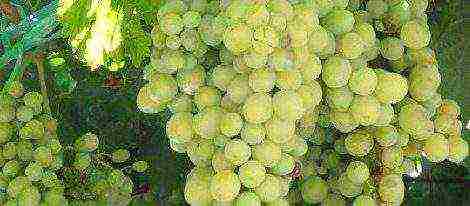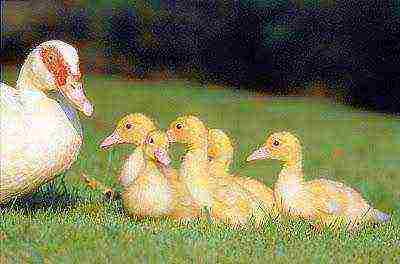Content
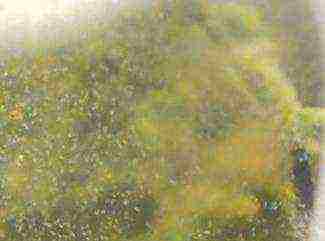 Those who have not forgotten the school course of biology will say with confidence that this is the most complex of unicellular organisms in its structure. That is, it has come close to multicellular in terms of developmental level. However, those who are interested in breeding ciliates at home are not biologists.
Those who have not forgotten the school course of biology will say with confidence that this is the most complex of unicellular organisms in its structure. That is, it has come close to multicellular in terms of developmental level. However, those who are interested in breeding ciliates at home are not biologists.
Why is an infusoria needed and what is it?
First of all, the length of the ciliate does not exceed half a millimeter, and in configuration it is similar to a shoe sole (hence the name). In nature, the ciliate shoe serves as the main food for fish fry, which are simply too tough for larger pieces of food. This is why it attracts attention ... not only of the fish themselves, but also of fishermen and aquarists.
How to grow ciliates at home?
Any living creature, even a single-celled one, needs nutrition. Infusoria-shoe is no exception. Microorganisms are the breeding ground for it. This means that it is required to prepare an environment where they will be in sufficient numbers. Take any container and fill it with aquarium water. Try to collect it closer to the surface where the plants come out. Almost every aquarium with a formed biological structure already has its own ciliates, even if they are still few.
Next, a salad leaf or pieces of banana peel are added to the container. Sometimes they are mixed with algal fish feed (granular). You can always buy it in almost every specialized outlet. Some experts recommend separating these types of food into different containers.
Both crops must be kept in the sun for at least a week (if longer, then even better). The optimal time for growing ciliates, therefore, is summer. When the water turns dark, it is a sign that a bacterial colony has developed. Next, ciliates come into play. You can track their appearance even without microscopes and magnifying glasses: the water should turn pinkish.
Everything worked out? You can propagate a colony by taking another container with a similar bacterial culture and adding some water from the first. The fry need to be fed literally with drops of water from the container where the ciliates live. If you add more food than the fry can eat, then the shoes will simply die, and their decay products will poison the water. Of course, it is better to start everything with water from an open reservoir, where there are much more ciliates. And in any case, it is advisable to have a microscope in order to assess the content of microorganisms accurately.
Did you like the article? Share!
Infusoria-shoe is a type of ciliates belonging to the group of alveolates. It got its name from its unusual shape, reminiscent of the sole of a shoe. Inhabits all fresh water bodies.
Description
The sizes of the shoes are tiny, but at the same time, relative to other unicellular ones, they are quite large. An adult shoe can reach sizes up to 0.3 mm, however, some managed to grow individuals up to 0.6 mm. The body is elongated, semicircular in section. The outer membrane serves as the upper shell for the body. It is transparent, so through it you can see the entire internal structure of the ciliates. The most prominent against the background of other organs is the macronucleus. It is manifested by a bold dot on the body. On the surface of the shoes are cilia, with the help of which the ciliate moves and hunts. Their number can vary from 10 to 15 thousand.
Why grow?
The fact is that fish fry cannot eat food that large individuals can easily swallow.To breed them, you need a special starter feed. Infusoria shoes are suitable as such food. Breeding them will not be difficult, but the fry, feeding on them, will grow healthier and stronger.
How to find an infusoria?
There is an easy and fun way to find, and most importantly, separate the shoe from other microorganisms:
- Take a piece of glass and place 2 drops of water on it, and one should be taken from the aquarium, and the second from the water tap, and left to stand for a while.
- Add a few grains of salt to the drop from the aquarium.
- Build a thin "path" of water between the drops. For this, any needle or toothpick can be suitable, it is enough to hold it between the drops. All fresh microorganisms will rush to clean, unsalted water.
- The shoe, due to its cilia, is much more agile than its counterparts. That is why none other than a thoroughbred ciliate will be the first in the water bridge.
- Using a pipette, we send it to a tank with clean water for further dilution.
How to cultivate?
In order to breed a shoe culture, no special conditions are needed, so their cultivation is very simple and within the power of many fish breeders.
To create a large colony of shoes, it is enough to acquire one. After about a month of maintenance, this shoe will give birth, and there will already be a colony of ciliates in the bank - more than 40 thousand copies per cubic centimeter. This number is the maximum concentration of the shoes in the water.
A specimen of ciliates should be placed in a glass jar (preferably 3 liter) of settled fresh water. The glass allows light to pass through, which improves colony growth. Room temperature is great to start breeding microorganisms, but 22-26 degrees is ideal for ciliates. At this temperature, it will be possible to grow a colony with the largest number of shoes. It is advisable to put the jar in a ventilated place or provide it with a purge. This is due to the fact that in the presence of oxygen in the water, the ciliates sink to the bottom, and if there is a lack of oxygen, they float, which helps with tracking and further collection.
What to feed
In food, shoes are also unpretentious. You can feed them at home. To feed, they need substrates for the development of bacteria. Eat any plant food, fish food, milk and liver. For convenience, the products are dried, and then dipped in gauze into a container with infusoria. In order not to overfeed them, a piece of about 2-3 cm will be enough.
You can also use hay infusion for feeding. It is very simple to prepare it. Dip the hay into boiling water, at the rate of 10 g per 1 liter and leave to simmer for 20 minutes. The high temperature will kill all microorganisms, but the bacteria will remain, it is they who will feed on the ciliates in the future. Pour the finished solution into any convenient container and leave it at room temperature for 2-3 days, during which time the bacteria will multiply, and they can be fed to ciliates. This type of food is called hydrolytic yeast, it should be added to the water at the rate of 1 g per 10 liters once a week and a half.
The easiest way to feed your ciliates is with milk and dairy products. Skim milk or plain condensed milk is best. Add 2 drops per week to the solution. Ciliates do not feed on milk itself, but on lactic acid bacteria.
When feeding a culture, it must be remembered that when the solution is oversaturated with bacteria, the ciliates will begin to die from insufficient air. To avoid such a situation, you need to carefully monitor the portions of bacteria that enter the reservoir for the shoes.
Use as feed
After successful breeding, you can start collecting ciliates. For convenience, it is advisable to move the entire colony to the surface of the water. Let's consider the 2 most convenient and easy ways to do this:
- Collecting with milk.
Pour the milk mixture into the water and turn off the blowdown.After that, it remains to wait 2 hours and the ciliates will float to the surface by themselves.
- Collect with salt.
A salt solution is added to the jar, forcing the ciliates to float to the surface.
Now you can start the collection itself. You can collect them using a hose. You can also build a structure that will constantly feed the fry with fresh ciliates. To do this, you need a regular IV tube, which can be purchased at the pharmacy. Place the jar with infusoria over the aquarium, insert the hose into it, lower it and adjust the water supply from the jar using the clamp. Ideally, the water should be dispensed in drops at intervals of 2-3 seconds.
Anyone can make such a mini-farm for breeding ciliates at home. Feeding on ciliates, the fry will grow healthy and strong, which means they will be able to live a long life.
The common amoeba (the kingdom of Animals, the sub-kingdom of the Protozoa) has another name - proteus, and is a representative of the free-living Sarcode class. It has a primitive structure and organization, moves with the help of temporary growths of cytoplasm, often called pseudopods. Proteus consists of only one cell, but this cell is a full-fledged independent organism.
Habitat
Most amoebas live in freshwater or salt water bodies, they can live in moist swampy soil. Parasitic species exist in the body of a person or animal. Common amoeba lives mainly at the bottom of fresh reservoirs with stagnant water. Prefers swampy, rotting ponds, where there are many bacteria. It also feels good in clean aquarium water. Easily reproduces in the laboratory.
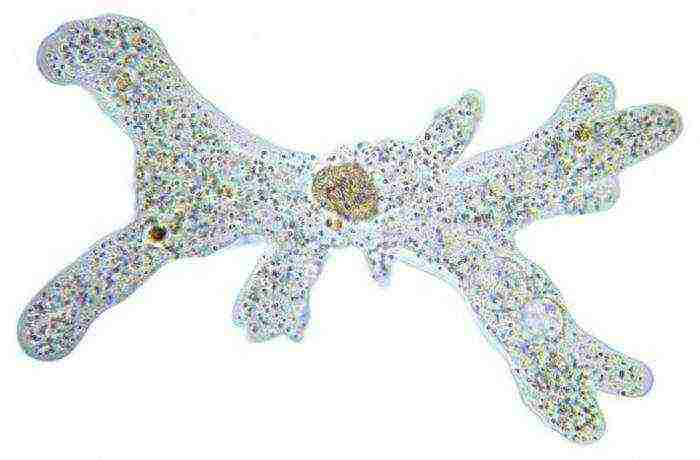
The structure of an ordinary amoeba
Common amoeba is an organism consisting of one cell, leading an independent existence. The body of the amoeba is a semi-liquid lump, 0.2-0.7 mm in size. Large individuals can be seen not only through a microscope, but also with a conventional magnifying glass. The entire surface of the body is covered with cytoplasm, which covers the gelatinous nucleus. During movement, the cytoplasm constantly changes its shape. Stretching in one direction or the other, the cell forms processes, thanks to which it moves and feeds. Can push off algae and other objects with pseudopods. So, in order to move, the amoeba pulls the pseudopod in the right direction, and then flows into it. The travel speed is about 10 mm per hour.
The proteus has no skeleton, which allows it to take any shape and change it as needed. The respiration of the common amoeba is carried out by the entire surface of the body; there is no special organ responsible for the supply of oxygen. During movement and feeding, the amoeba captures a lot of water. Excess of this fluid is secreted with the help of a contractile vacuole, which bursts, expelling water, and then forms again. The common amoeba has no special sense organs. But she tries to hide from direct sunlight, she is sensitive to mechanical irritants and some chemicals.
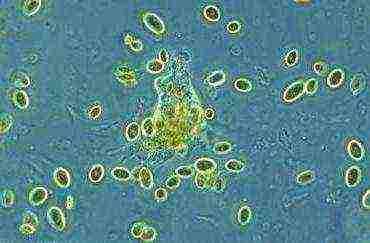
Food
Proteus feeds on unicellular algae, rotting residues, bacteria and other small organisms, which it captures with its pseudopods and sucks in so that food is inside the body. Here, a special vacuole is immediately formed, where the digestive juice is released. The common amoeba can feed anywhere in the cell. Several pseudopods can seize food at the same time, then the digestion of food occurs in several parts of the amoeba at once. Nutrients enter the cytoplasm and go to build the body of the amoeba. Particles of bacteria or algae are digested, and the remains of vital activity are immediately removed to the outside. The common amoeba is capable of throwing out unnecessary substances on any part of its body.
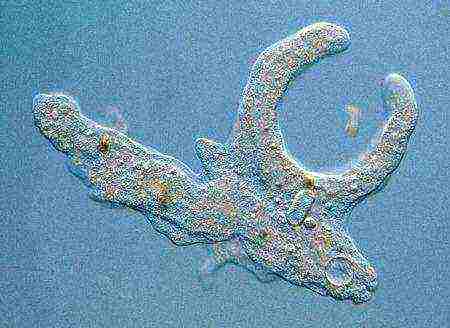
Reproduction
Reproduction of the common amoeba occurs by dividing one organism into two. When the cell has grown enough, a second nucleus is formed in it. This serves as a signal for division. The amoeba is elongated, and the nuclei diverge on opposite sides. A constriction appears approximately in the middle. Then the cytoplasm in this place bursts, so two separate organisms arise. Each of them contains a core. The contractile vacuole remains in one of the amoebas, while a new one arises in the other. During the day, the amoeba can divide several times. Reproduction takes place during the warm season.
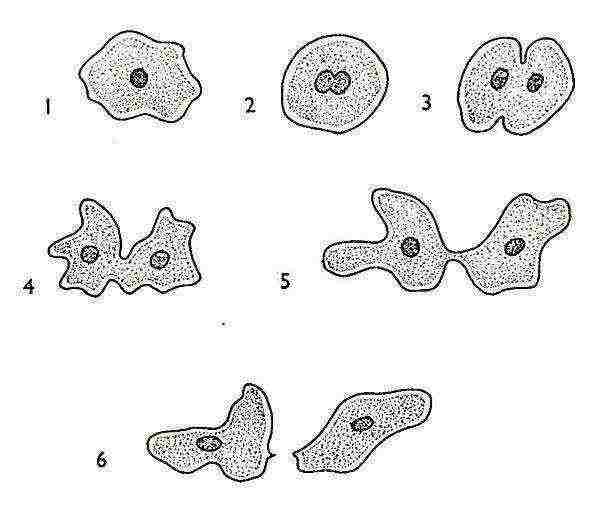
Cyst formation
With the onset of cold weather, the amoeba stops eating. Its pseudopods are drawn into the body, which takes the shape of a ball. A special protective film is formed on the entire surface - a cyst (of protein origin). Inside the cyst, the body is in hibernation, does not dry out and does not freeze. In this state, the amoeba stays until the onset of favorable conditions. When the reservoir dries up, cysts can be carried by the wind over long distances. In this way, amoebas settle in other bodies of water. With the onset of warmth and suitable humidity, the amoeba leaves the cyst, releases pseudopods and begins to feed and reproduce.
The place of the amoeba in wildlife
The simplest organisms are a necessary link in any ecosystem. The value of the common amoeba lies in its ability to regulate the number of bacteria and pathogens that it feeds on. The simplest unicellular organisms eat rotting organic residues, maintaining the biological balance of water bodies. In addition, the common amoeba is food for small fish, crustaceans, insects. And those, in turn, are eaten by larger fish and freshwater animals. The same protozoan organisms serve as objects of scientific research. Large accumulations of unicellular organisms, including the common amoeba, participated in the formation of limestones and chalk deposits.
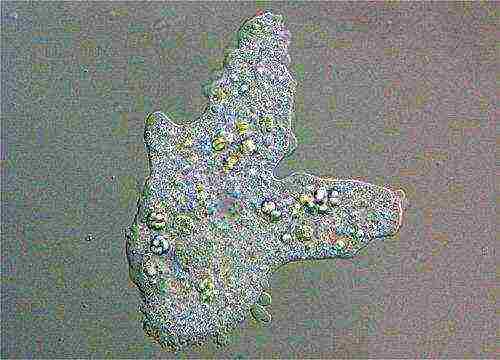
Amoeba dysentery
There are several varieties of the simplest amoebas. The most dangerous to humans is dysentery amoeba. It differs from the common one in shorter pseudopods. Once in the human body, the dysentery amoeba settles in the intestines, feeds on blood, tissues, forms ulcers and causes intestinal dysentery.
The success of the laboratory practice depends on the availability of handouts for students to study. The following are guidelines for collecting, maintaining, processing and storing handouts. The collection and preparation of handouts can be done by students. To do this, they are given a specific summer collection task and instructions for preparing the handout.
To provide students with animals of the subkingdom Protozoa in sufficient quantities can only be cultivated. Protozoa can be cultivated directly at school (in a laboratory laboratory of biology) or at home with students or members of a biological circle. Many protozoa can cohabit in a mixed culture, but pure cultures of certain protozoan species can also be prepared.
For keeping the protozoa, only transparent (not green) glassware is used. The use of metal utensils is excluded, since metal has a harmful effect on animals. Ordinary canning jars are suitable for keeping protozoa, but jars with a rectangular bottom, rectangular cups, crystallizers, yogurt and Petri dishes are preferable.
For the cultivation of protozoa, it is best to use rain or melt water. Before use, river, lake or pond water is boiled and filtered either through thick silk or through a paper filter. Since tap water is chlorinated, it is not suitable for keeping protozoa.If you have to resort to using tap water, then it is preliminarily defended for 7-10 days in a glass vessel (while the water is periodically stirred with a glass rod). During settling, chlorine gradually evaporates, and the water is saturated with oxygen. The water is filtered before use. But even settled water should be used carefully, as you can ruin the culture of protozoa. As the water evaporates, fresh water is added to the vessel, keeping, if possible, the same level.
Water temperature and lighting play an important role in breeding protozoa. The most favorable temperature is 18-23 ° C. Care must be taken to avoid sudden temperature fluctuations. Many protozoans need good daylight, so jars with the culture of protozoa are placed near the window, but at the same time, direct sunlight should not be allowed to fall on them (for protection, you can use any screens - a curtain, screen, etc.).
Do not allow water to be contaminated with any chemical substances. When taking culture samples, use pipettes specially designated for this purpose. The samples taken for viewing are poured into disinfectant solutions. Jars with cultures are kept closed with glass plates. This reduces water evaporation and dust contamination of the crop. For culture vessels, it is best to set aside a special place and do not move them, thereby avoiding shaking the liquid.
For the cultivation of protozoa, it is necessary to prepare in advance a nutrient medium rich in bacteria, which most often serve as food for them. There are several different recipes for preparing culture media.
- A layer of hay dust or chopped meadow hay (leaves can be) 0.5 cm thick is placed in a glass jar and poured with rain or pond water. The jar is covered with glass and placed on the window, but so that it is protected from direct sunlight. After 3-4 days, water is added to the vessel from a polluted stagnant reservoir, at the bottom of which there is rotting vegetation. In this case, you should capture some silt from the bottom. After a while, a film appears on the surface of the liquid in the vessel. As a rule, various small ciliates first appear in the prepared medium, then amoeba (they should be looked for first of all in the film) and, finally, shoe ciliates (on average, 15 days after adding pond water).
- In a bag of gauze, boil lettuce leaves, which can also be grown on the windowsill. Pour pond water into a small jar and put a bag of salad in it. After 3-5 days, the salad needs to be changed. In this nutrient medium, as a rule, a large number of ciliates appear.
- Put pieces of gills or toothless legs in water for several days. The appeared ciliates are caught with a pipette and transferred to a vessel with salad.
- If you take water from a dirty reservoir with rotting plants, along with dirt and rot, cover it with glass and leave it to stand quietly for several days, then after a while you can get a lot of ciliates and amoebas.
- If you add either 10-15 drops of milk, or a pinch of potato flour, or oatmeal (rice, wheat) broth to 200 cm3 of the nutrient medium, you can get a large number of large protozoa. A decoction of cereals is prepared as follows: 50-100 g of cereals 20-30 minutes. boil in 1 liter of water. The resulting broth is poured into a bottle, corked and added to the culture, 5-10 cm3 as needed.
- Prepare two infusions: 1) young leafy branches of birch or other trees in raw (not tap) water; 2) garden soil (1/4 volume) in raw water (3/4 volume). After 10 days, both solutions are poured together in equal volumes, and then, after 6-8 days, amoebas are added to the prepared nutrient medium. If every 2-3 months amoebas are transplanted into a fresh nutrient medium, then they can be kept throughout the year.
- A large number of ciliates can be obtained in the infusion of porcine brain. Cut 120 g of brain into pieces and crush in water, after 12 hours filter through cheesecloth. By adding water, bring the volume of the infusion to 1 liter, pour the resulting liquid into several glass jars and add 1 cm3 of hay infusion with ciliates to each. After 2-3 days, you can get a large number of ciliates. The film that forms on the surface of the liquid should be removed daily.
- Boil rice or wheat grains for a few minutes. Simultaneously boil water in another flask, cool it, pour it into several cups (for example, Petri dish) and place several prepared grains in each.
The culture medium prepared in any way should remain open for 7-10 days so that as many bacteria as possible can multiply in it.
In the laboratory's biology office, you can keep a "neglected" aquarium, in which you can find the invertebrates you need for training. Before the start of the school year, a thin layer of sand (1.5 cm) is poured into a medium-sized aquarium and a layer of soil with rotting leaves and twigs (1-1.5 cm) taken from the bottom of the pond is placed on it. Elodea, pond and other aquatic plants are planted in the ground without washing them. They should occupy more than half of the aquarium, and cover the bottom surface free of plants with a thin layer of sand. The aquarium is filled with pond water and left unattended, adding evaporating water from time to time. In the same aquarium, you can keep various mollusks, water larvae, etc.
A mixed culture of protozoa is prepared about a month before using it in the classroom. Periodically, the culture is examined, samples are taken from the bottom, from the surface, from the middle of the vessel, while it is noted in which jar and in which place the accumulation of protozoa is found and which ones.
In mixed cultures, various protozoa develop, and their species composition is constantly changing. Therefore, it is better to have pure crops to work with. To do this, a few drops of a mixed culture or water samples from reservoirs are applied to a glass slide without covering it with a coverslip. At low magnification of the microscope, the prepared microscope is examined. Using a pipette with a strongly drawn end, the desired animals are caught and transferred into a vessel with a nutrient medium. The nutrient medium must be pre-boiled and cooled. The container is tightly closed with glass. Samples are periodically taken and the development of the protozoa is monitored. To preserve the purity of the culture for a long time, the animals are periodically (about once a month) transplanted into a fresh nutrient medium.
